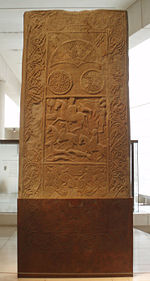- Hilton of Cadboll Stone
-
 Original Hilton of Cadboll Stone im National Museum of Scotland
Original Hilton of Cadboll Stone im National Museum of Scotland
Der Hilton of Cadboll Stone ist ein so genannter Class II Kreuzstein, der in Hilton of Cadboll auf der schottischen Halbinsel Tarbat in Easter Ross nahe einer Kapelle gefunden wurde. Der im 8. Jahrhundert geschnitzte Stein wurde im 17. Jahrhundert als Grabplatte wieder verwendet. Die Kreuzseite wurde dabei zerstört und durch eine moderne Inschrift ersetzt. Die Rückseite ist ein schöner und reich geschmückter Piktischer Symbolstein.
Unter den piktischen Symbolen des Halbmondes, des V-Stabes und der Doppelscheibe befindet sich eine Jagdszene. Darin befindet sich die äußerst seltene Darstellung einer galoppierenden Reiterin mit einer großen Ringfibel, die im Damensattel sitzt. Vor ihr befindet sich ein Spiegel- und Kamm-Symbol. Sie scheint etwas in ihrem linken Arm zu halten. Zwei Reiter, zwei Hörner blasende Jäger zu Fuß, Hunde und Rehe bilden den Rest der Jagdszene. Der untere Tafelteil enthält Spiralmuster. Der komplizierte Rahmen hat den Lebensbaum mit Vögeln als Motiv.
Ausgrabungen in den Ruinen der knapp 10 km entfernten St. Colman's Church in Portmahomack und in ihrer Umgebung legten ein Kloster aus dem 6. Jahrhundert frei. Der Stein befindet sich heute im National Museum of Scotland. Eine Replik wurde vor Ort aufgestellt.
Literatur
- E. J. Cowan, R. Andrew McDonald (Hrsg.): Alba. Celtic Scotland in the medieval era. Tuckwell, East Linton 2000, ISBN 1-86232-151-5, S. 76–87.
- Richard Feachem: Guide to prehistoric Scotland. 2nd edition. Batsford, London 1977, ISBN 0-7134-3264-0.
Weblinks
57.7672-3.896Koordinaten: 57° 46′ 2″ N, 3° 53′ 46″ WKategorien:- Archäologischer Fundplatz (Highland)
- Pikten
- Kunst der Vor- und Frühgeschichte
Wikimedia Foundation.


